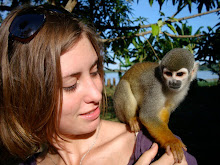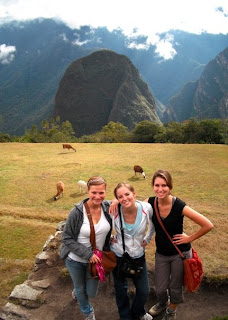For the project, my group members and I have chosen to study the non-cristian beliefs still in existence in the community. It was really interesting to talk to the people and to hear some of their stories.
I met some pretty interesting people in San Pedro de Casta. This man's name is Manuel Olivares and can be considered a sort of "man of the mountain." He spent a lot of time with the Swiss manwho discovered Marcahuasi less than a decade ago. In his younger years Marcahuasi was his paradise and he dared the 2 hour climb over a hundred times. Now he is nearly blind and deaf but still loves to talk about his adventures in Marcahuasi and it seems that he cherrishes it as his contribution to his pueblo.
Here is the sweet little lady who told us all about her experience with Soqta Kuri, the man considered to have rid San Pedro de Casta of the seven headed serpent who used to do harm to the people. Everyone knows Soqta Kuri and fears his awful storms. Fortunately he now lives in Bolivia and only returns every 3 or 5 years.
4,200 meters (12,600 feet) above sea level and litterally at the top of a mountain in the Andes are the ancient rock formations of Marcahuasi. During my second visit to San Pedro de Casta I did the climb. It was the hardest climb I think I have ever done but it was well worth it once I reached the top. The humanity rock has 7 faces in total.. this one is the most famous.
I sat by this lake for a while in silence.  There was not a sound and the water was perfectly still. Living in Lima I have not experienced real silence in 3 and a half months.. literally. The only company were a couple of donkies roaming around. It was pretty unbelievable to be on the top of a mountain where I was at eye level with all of the clouds and mountain tops.
There was not a sound and the water was perfectly still. Living in Lima I have not experienced real silence in 3 and a half months.. literally. The only company were a couple of donkies roaming around. It was pretty unbelievable to be on the top of a mountain where I was at eye level with all of the clouds and mountain tops.
These would be the "mummies" that were found in Marcahuasi. Really they are just very frightning skeletons in glass cases that are open on the top. The interesting part is that for my study I learned about the belief in the "gentiles" who are thought to have been the ancient ancestors. The skeletons have been incorporated into this belief in San Pedro de Casta and it is thought that the skeletons found in Marcahuasi were the gentiles (their ancestors) and that they had fled to the top of the mountain from the spanish conquistadors because they did not want to be christian. The leaves in the bottom of the case and on the table are coca leaves. I asked the lady who ran the "museum" why there were coca leaves in the cases and she said they were offerings to the gentiles. I then asked her why they needed to make offerings and she said that when people take pictures you must give them offerings of coca leaves and that if you don't they won't let you sleep at night. When we asked other people about the gentiles they also refered to the mummies and gave us similar information about the offering of coca leaves and about what might happen should they not recieve these offerings.








































